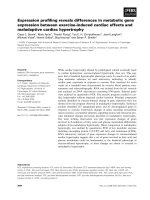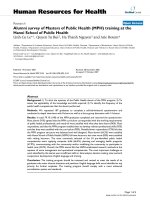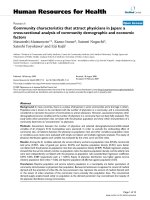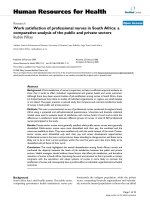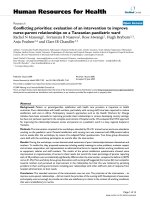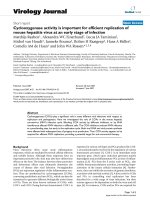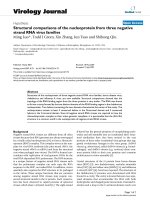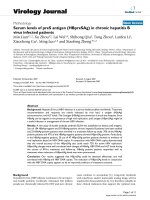Báo cáo sinh học: " Two dimensional VOPBA reveals laminin receptor (LAMR1) interaction with dengue virus serotypes 1, 2 and 3" pptx
Bạn đang xem bản rút gọn của tài liệu. Xem và tải ngay bản đầy đủ của tài liệu tại đây (2.24 MB, 11 trang )
BioMed Central
Page 1 of 11
(page number not for citation purposes)
Virology Journal
Open Access
Research
Two dimensional VOPBA reveals laminin receptor (LAMR1)
interaction with dengue virus serotypes 1, 2 and 3
Phaik Hooi Tio, Wan Wui Jong and Mary Jane Cardosa*
Address: Institute of Health and Community Medicine, Universiti Malaysia Sarawak, 94300 Kota Samarahan, Sarawak, Malaysia
Email: Phaik Hooi Tio - ; Wan Wui Jong - ; Mary Jane Cardosa* -
* Corresponding author
Abstract
Background: The search for the dengue virus receptor has generated many candidates often
identified only by molecular mass. The wide host range of the viruses in vitro combined with multiple
approaches to identifying the receptor(s) has led to the notion that many receptors or attachment
proteins may be involved and that the different dengue virus serotypes may utilize different
receptors on the same cells as well as on different cell types.
Results: In this study we used sequential extraction of PS Clone D cell monolayers with the
detergent β-octylglucopyranoside followed by sodium deoxycholate to prepare a cell membrane-
rich fraction. We then used 2 dimensional (2D) gel electrophoresis to separate the membrane
proteins and applied a modified virus overlay protein binding assay (VOPBA) to show that dengue
virus serotypes 1, 2 and 3 all interact with the 37 kDa/67 kDa laminin receptor (LAMR1), a common
non-integrin surface protein on many cell types.
Conclusion: At least 3 of the 4 dengue serotypes interact with the 37 kDa/67 kDa laminin
receptor, LAMR1, which may be a common player in dengue virus-cell surface interaction.
Background
The dengue viruses have become recognized as important
global pathogens causing dengue haemorrhagic fever not
only in Southeast Asia but also in South and Central
America and in the Caribbean.[1,2]. There are 4 closely
related dengue viruses referred to as DENV-1, DENV-2,
DENV-3 and DENV-4[3]. They are mosquito borne
viruses with a single stranded positive sense RNA genome
around 11 kilobases in length, and are able to infect both
mosquito and human hosts. A wide range of cell types
from multiple species is susceptible to infection with den-
gue viruses in vitro. Numerous studies have attempted to
identify the cell surface receptor or receptors utilized by
the dengue viruses to gain entry into susceptible cells, but
multiple approaches using different cell lines and differ-
ent dengue virus strains have generated many candidate
DENV interacting proteins identified in some cases only
by molecular mass [4-11]. Heparan sulfates[12] and the
C-type lectins DC-SIGN and L-SIGN have been shown to
mediate infection by dengue viruses[13] and most
recently, studies using a standard virus overlay protein
binding assay (VOPBA) have suggested that in the liver
cell line HepG2, different DENV serotypes utilize different
cell surface molecules[14]. More specifically, mass spec-
trometric methods have been used to identify reactive
bands using VOPBA and it has been suggested that DENV-
2 interacts with GRP78[15] while DENV-1 interacts with
the 37 kDa/67 kDa high affinity laminin receptor[16].
Published: 25 March 2005
Virology Journal 2005, 2:25 doi:10.1186/1743-422X-2-25
Received: 24 February 2005
Accepted: 25 March 2005
This article is available from: />© 2005 Tio et al; licensee BioMed Central Ltd.
This is an Open Access article distributed under the terms of the Creative Commons Attribution License ( />),
which permits unrestricted use, distribution, and reproduction in any medium, provided the original work is properly cited.
Virology Journal 2005, 2:25 />Page 2 of 11
(page number not for citation purposes)
In a standard VOPBA, complex protein preparations are
separated according to molecular mass in a single dimen-
sion and transferred to membranes to be probed with
virus antigen[17,18]. When complex mixtures are used
there are often many co-migrating proteins that cannot be
adequately resolved for accurate interpretation of mass
spectrometric data when single dimension separations are
used. We have used two dimensional (2D) gel electro-
phoresis[19] for separation of cell membrane prepara-
tions. After electrotransfer of 2D gel-separated proteins to
nitrocellulose membranes, we probed the membranes
with various dengue virus antigen preparations. This 2D
VOPBA approach has facilitated the separation of multi-
ple proteins of similar molecular mass along a pH gradi-
ent. Reactive spots recovered using this approach were
identified on companion 2D gels using matrix assisted
laser desorption ionization-time of flight mass spectrom-
etry (MALDI TOF MS)[20]. A schematic diagram of our
experimental design is shown in figure 1. To the best of
our knowledge, this is the first description of the use of 2D
VOPBA for identification of proteins interacting with
flaviviruses.
Results
Identification of reference protein spots in detergent
extracts of PS Clone D cell monolayer
The proteomic profile of 1% sodium deoxycholate
(NaDOC) soluble proteins from PS Clone D cell monol-
ayers is shown in figure 2a. Numerous spots were seen
and it was necessary to attempt to fractionate the compo-
nents of the cell monolayer by sequential treatment with
1% β octyl-glucopyranoside (βOG) followed by 1%
NaDOC. Beta octyl-glucopyranoside soluble proteins and
post-βOG residual NaDOC-extracted proteins were
resolved separately on 2D gels. Major protein spots were
picked and subjected to in-gel trypsin digestion followed
by MALDI-TOF MS. It was found that the βOG extract
contained both cytoplasmic as well as some membrane
proteins while the post-βOG residual NaDOC extract con-
tained mainly cytoskeletal and nucleus associated pro-
teins. Figures 2b and 2c show some of the major spots
identified and used as identifying features when compar-
ing overlays of Ponceau S stained blots with VOPBA devel-
oped blots. In figure 2b showing separation of βOG
extracts, BiP or GRP78 was prominent as was calreticulin,
alpha enolase, HSP70, PDI and actin. Circled spots were
reactive in the 2D VOPBAs described later and are shown
here to provide the protein landscape in which these reac-
tive proteins exist. In figure 2c, showing separation of
βOG-insoluble NaDOC-extracted proteins, BiP/GRP78
was less prominent but vimentin and nucleophosmin
were highly prominent. Again the circled spots mark the
positions of VOPBA-reactive spots, showing the location
of these very sparse proteins in the landscape of much
more abundant protein spots.
2D VOPBA of
β
octyl-glucopyranoside extract
2D gel blots of βOG extracted PS Clone D cells were
probed with a cocktail of antigens prepared from 4 differ-
ent dengue virus serotypes grown in C6/36 mosquito
cells. Bound envelope protein (E) was detected by using
the monoclonal antibody 4G2, a flavivirus-reactive anti-E
antibody[21]. Replicate blots were also probed with indi-
vidual dengue serotypes separately. Antigens prepared
from uninfected mosquito cells were used as negative con-
trols in order to identify non-dengue specific interactions
present in all blots. These blots are shown in figure 3. In
the 2D VOPBA blots probed with a dengue virus antigen
or cocktail, 2 reactive spots were seen. The blots probed
with dengue cocktail, DENV-1, DENV-2 and DENV-3 had
identical reactivities. The major spot that was clearly reac-
tive was around 45 kD in molecular mass with a pI of 4–
5. A weaker, less obvious reaction was seen with a spot at
50–60 kD and a slightly higher pI of around 5. MALDI-
TOF MS-generated peptide mass fingerprints identified
these spots as 37 kDa/67 kDa laminin binding protein or
laminin receptor (LAMR1) and an SH3 domain-contain-
ing protein, Hip 55, respectively. The blot probed with
DENV-4 did not show any reactivity with LAMR1 but
there was a weak reactivity with Hip 55. Furthermore, a
clearly reactive pair of spots identified as p47 protein (a
cofactor of NSFL1/p97) was seen in the DENV-4 VOPBA.
2D VOPBA of sodium deoxycholate extract of cells
previously extracted with
β
octyl-glucopyranoside
Residual protein from PS Clone D cells treated with βOG
was further treated with NaDOC and the resulting extract
was used to prepare 2D gel blots. VOPBAs were performed
as above and figure 4 shows the individual VOPBA blots.
As with the βOG-extract, LAMR1 was found to be reactive
in VOPBA blots probed with dengue cocktail, DENV-1,
DENV-2 and DENV-3, but not DENV-4. Instead, the
DENV-4-probed blot showed a clear reaction with a pro-
tein of higher molecular mass and higher pI than LAMR1.
This protein was identified to be lamin B1, a nuclear
membrane protein.
MALDI TOF MS
Peptide mass fingerprints were obtained using Voyager
DE STR (Applied Biosystems, Foster City, CA, USA) and
mass lists were submitted for search against the NCBI pro-
tein database (National Institutes of Health, Bethesda,
MD, USA) using the MASCOT search engine[22]. Spectra
and their corresponding mass-lists generated from analy-
sis of the tryptic digests are provided as additional files
1,2,3,4,5.
Immunoblot confirmation of LAMR1 and lamin B1 spots
on 2D gel blots
The NaDOC soluble proteins from βOG extracted PS
Clone D cells were used to prepare 2D gel blots and these
Virology Journal 2005, 2:25 />Page 3 of 11
(page number not for citation purposes)
Flowchart of experimental designFigure 1
Flowchart of experimental design. This describes the steps in the process of identifying dengue virus reactive proteins by
2D VOPBA to facilitate picking the relevant spots from a gel run under identical conditions and at the same time as those
which were used for electrotransfer to nictrocellulose membranes.
Overlay scans to
identify reactive
spots
BLOT TO NITROCELLULOSE
STAIN WITH PONCEAU S AND SCAN
STAINED BLOT FOR POSITIONS OF
SPOTS
VOPBA THEN SCAN FOR POSITIONS OF
REACTIVE SPOTS
STAIN WITH
COOMASIE BLUE
Pick reactive spots from
Coomasie Blue stained 2D
gel
MONOLAYER
EXTRACT WITH DETERGENTS
CLEANUP
1
s
t
DIMENSION SEPARATION
pH3-10
2
n
d
DIMENSION SEPARATION
mass separation
Virology Journal 2005, 2:25 />Page 4 of 11
(page number not for citation purposes)
were probed with antibodies specific for LAMR1 and
lamin B1. Figure 5a shows a Ponceau S stained blot and
the dengue virus antigen reactive spots are circled. The
locations of specific staining by antibodies to LAMR1 and
lamin B1 on the 2D blots were confirmed to be in the
positions of the spots identified by MALDI TOF MS as
LAMR1 and lamin B1 (figures 5b and 5c).
LAMR1 is expressed on the surface of PS Clone D cells
When PS Clone D cells were fixed with paraformaldehyde
LAMR1 staining was seen on the surface of the cells. In
keeping with observations of de Hoog and coworkers[23]
we found that single cells at the edges of the monolayer
were consistently displaying brightly fluorescent patches
on the cell surfaces showing high levels of expression of
LAMR1. In the centres of the monolayers where cells were
contact inhibited, LAMR1 staining was more muted and
more evenly distributed over the cells (see figure 6).
Discussion
The investigation of early events in the infection of suscep-
tible cells by dengue viruses is important in the quest to
understand the ability of this group of mosquito borne
viruses to infect both insect and mammalian cells, yet
appear to have a restricted tissue tropism in the human
host. Determination of the nature of the early interactions
of the infecting viruses with molecules on the surface of
susceptible cells provides for the possibility that this
understanding can lead to the development of therapeutic
agents that can be used to inhibit virus infection. The lam-
inin receptor has already been described as a receptor for
DENV-1 by single dimension VOPBA followed by MS/
MS[16]. The results from the MASCOT[22] search showed
multiple hits in this particular study, indicating several
possibilities, including ATP synthase β chain, β actin and
the laminin receptor, but the authors selected the lower
scoring laminin receptor for further investigation. This
was a reasonable choice since this molecule has previ-
ously been identified as a receptor for the alphaviruses
Sindbis virus[24] and Venezuelan equine encephalitis
virus (VEEV)[25] and the flavivirus tick-borne encephali-
tis virus (TBEV)[26].
In our study, 2D VOPBA was used to eliminate the prob-
lem of co-migrating bands in a single dimension and the
mass list generated from trypsin digestion of the most
prominent reactive spot turned up numerous hits unam-
biguously listing the same protein, variously known as
protein 40 kD, laminin-binding protein, 34/67 kDa lam-
inin receptor, laminin receptor 1, LAMR1, Lamr1 protein,
67 kDa laminin receptor, 40S ribosomal protein SA, and
so on. Contrary to earlier suggestions that LAMR1 is a
DENV-1 specific receptor[14,16], in our hands, DENV-1,
DENV-2 and DENV-3 were all shown to interact with the
same molecule LAMR1 although DENV-4 did not. It is
2D gel electrophoresis image of detergent extracts from PS Clone D cell monolayerFigure 2
2D gel electrophoresis image of detergent extracts
from PS Clone D cell monolayer. The first dimension
was run on linear 7 cm IPG strip, pH 3-10. The second
dimension was 10% SDS PAGE. The gel was stained with
coomasie brilliant blue and spots were picked and subjected
to in-gel trypsin digestion. The major spots identified by
MALDI TOF are labelled. Circled spots were reactive in the
2D VOPBA. (a) NaDOC-extract (b) βOG-extract (c)
NaDOC-extract after removal of βOG-soluble proteins.
Virology Journal 2005, 2:25 />Page 5 of 11
(page number not for citation purposes)
thus likely that in the PS Clone D cells we have studied, at
least 3 of the 4 different dengue serotypes utilize the same
surface protein to gain entry into the cells. In our study we
also did not find any evidence of DENV-2 binding to BiP/
GRP78 as has been shown using single dimension
VOPBA[15].
LAMR1 is a non-integrin receptor interacting with the
extracellular matrix. It is generally accepted that the 37
kDa form is the precursor to the 67 kDa form although it
is still not clear how this transition occurs. We have used
a commercially available rabbit polyclonal antibody
raised against a recombinant protein corresponding to
amino acids 110–250 of human LAMR1 to show that this
protein can be found in patches on the surface of PS clone
D cells which are not contact inhibited in vitro. This distri-
bution of LAMR1 is consistent with the findings of Don-
aldson et al[27], and it is thus possible that LAMR1 may
be utilized as a receptor by the dengue viruses. Other
groups have already shown that LAMR1 is a functional
receptor for Sindbis virus, VEEV, TBEV and DENV1[16,24-
26]. We have not included functional studies in this
present work, as this study is meant to be an exploratory
study of dengue virus interacting proteins in PS Clone D
cells using 2D VOPBA as an interrogating tool. There is no
doubt that the treatment of the cell extracts limits the abil-
ity of this method to identify interactions dependent
upon conformational structures, nevertheless, we man-
aged to identify LAMR1 confirming previous observations
by other investigators[27]. We have further shown that
LAMR1 interaction is not limited to DENV-1 alone, but
that DENV-2 and DENV-3 also interact with LAMR1 and
that this may be a common receptor for dengue virus
entry into cells.
Many integrins have been shown to function as receptors
for different viruses, for example the α6 integrins mediate
human papillomavirus entry[28], β3 integrins mediates
cell entry by hantaviruses.[29], α2β1 integrin is a receptor
for human echovirus 1.[30,31], α5β1 integrin binds
human parvovirus B19[32], α2β1 and αxβ2 mediate rota-
virus infection[33] and αvβ3 is the receptor for the flaviv-
irus West Nile virus (WNV).[34]. Many viruses are now
known to infect cells through a multistep process involv-
ing binding to the cell surface followed by internalization,
often through interacting with more than one surface
molecule. Outside-in binding of integrins leads also to
signal transduction, and this functional activation has
2D VOPBA of β octyl-glucopyranoside soluble proteins from PS Clone D cell monolayerFigure 3
2D VOPBA of β octyl-glucopyranoside soluble proteins from PS Clone D cell monolayer. The antigen preparation
used in the VOPBA staining of the 2D blots is labelled on the bottom left of each blot. Two images are superimposed in each
panel. The Ponceau S scan of each blot is shown in greyscale and shows the universe of spots transferred to the blot. The spots
reactive in the VOPBA analysis are shown in blue. Spots marked with an arrow were identified as Hip-55, those marked with a
circle were identified as LAMR1 and the pair of spots in the DENV4 blot marked with a rectangle were identified as p47 pro-
tein (NSFL1 cofactor).
Virology Journal 2005, 2:25 />Page 6 of 11
(page number not for citation purposes)
been shown to be necessary for internalization as in the
example of human parvovirus B19. In the case of adeno-
viruses, integrin clustering due to receptor binding initi-
ates the signalling events required for internalization[35].
The finding that DENV-1, DENV-2 and DENV-3 interact
with the laminin receptor is thus consistent with this
growing body of work describing the utilization by viruses
of extracellular matrix protein receptors for gaining entry
into cells.
In this study we have also identified dengue virus enve-
lope protein interaction with an actin binding protein
Hip55, which has been shown to be involved in endocy-
tosis, vesicular transport and signal transduction[36].
Hip55 has also been shown to interact with CD2v protein
of African swine fever virus (ASFV) and colocalizes to
areas surrounding perinuclear virus factories in ASFV
infected cells[37]. The role of Hip55 in the life cycle of
dengue virus should be further investigated.
In our preparations of dengue virus antigens, DENV-4
antigen had the weakest reactivity in ELISA (data not
shown) suggesting a lower titre of antigen than the other
3 serotypes, but the DENV-4 2D VOPBA did show a
different reactivity pattern, picking out lamin B1 instead
of LAMR1. Lamin B1 is not a plasma membrane protein
but is part of the nuclear membrane[38,39] and is thus
unlikely to be an alternative receptor for DENV-4. The sig-
nificance of the reaction of DENV-4 envelope protein with
lamin B1 is unclear and will be the subject of further stud-
ies. It is also interesting that DENV-4 envelope also
reacted with another protein involved in vesicle transport
and target membrane fusion, the p47 protein cofactor of
NSFL1/p97[40]. The similarity of function of the p47
protein with that of Hip 55, which is reactive with all 4
dengue serotypes, suggests that DENV-4 may use a differ-
ent pathway than DENV-1, DENV-2 and DENV-3 in the
course of infection of a particular cell.
Conclusion
Two-dimensional VOPBA was used to identify cell mem-
brane proteins interacting with dengue virus envelope
protein. This approach identified several interactors
including LAMR1, a non-integrin laminin binding pro-
tein, which has previously been suggested as a receptor for
DENV-1 but not other dengue virus serotypes. Using more
rigorous tools we have shown clearly that LAMR1 interacts
not only with DENV-1 but also with DENV-2 and DENV-
3. We have further shown that dengue virus envelope
protein from all 4 serotypes also interacts with an actin
2D VOPBA of sodium deoxycholate soluble proteins after β octyl-glucopyranoside extraction of PS Clone D cell monolayerFigure 4
2D VOPBA of sodium deoxycholate soluble proteins after β octyl-glucopyranoside extraction of PS Clone D
cell monolayer. The antigen preparation used in the VOPBA staining of the 2D blots is labelled on the bottom left of each
blot. Two images are superimposed in each panel. The Ponceau S scan of each blot is shown in greyscale and shows the uni-
verse of spots transferred to the blot. The spots reactive in the VOPBA analysis are shown in blue. Spots marked with a circle
were identified as LAMR1 and the spot in the DENV4 blot marked with a rectangle was identified as lamin B1.
Virology Journal 2005, 2:25 />Page 7 of 11
(page number not for citation purposes)
binding protein Hip55 and that DENV-4 differs from the
other three dengue virus serotypes in that it's envelope
protein interacts with lamin B1 and p47 and does not
interact with LAMR1.
Methods
Preparation of virus antigens
The 4 prototype dengue viruses were used in this study. All
viruses were propagated in Aedes albopictus C6/36 cells
grown in Leibovitz 15 media supplemented with 5% heat
inactivated foetal calf serum, antibiotics and 10% tryptose
phosphate broth. Antigens were prepared by inoculating
C6/36 cell monolayers with the different DENV serotypes
as described previously[41] and harvested when syncy-
tium formation was extensive. Cell culture fluids were
clarified by centrifugation before use. Fluids similarly pre-
pared from mock infected C6/36 cells were used as nega-
tive antigen controls.
Preparation of cell and membrane extracts
Just confluent flasks of the porcine kidney cell line PS
Clone D were used in the preparation of detergent extracts
for separation by 2D gel electrophoresis. Monolayers were
washed twice with phosphate buffered saline (PBS) before
subjecting to treatment with 1% β octyl-glucopyranoside
(βOG) in a hypotonic buffer containing 10 mM HEPES,
1.5 mM MgCl
2
, 5 mM KCl and a protease inhibitor
cocktail (Boehringer Mannheim GmbH, Germany), pH
7.5 rocking at 4°C for 1 hour. The solution was removed
and designated βOG-extract.
The remaining membranes, cytoskeleton and nuclei were
then washed for 1 hour at 4°C with a solution containing
2% CHAPS in the same buffer as described above. The
resulting solution was discarded and the residual material
solubilized by rocking at 4°C for 1 hour in the above
buffer containing 1% sodium deoxycholate (NaDOC).
The resulting solution was removed and designated βOG-
insoluble NaDOC-extract.
All extracts were spun in a microfuge at 14,000 rpm for 10
minutes and the supernatants stored at -20°C until use.
Sample preparation for 2D gel electrophoresis
All samples were prepared for 2D gel electrophoresis
using the Ready Prep 2-D Cleanup Kit (BioRad Laborato-
ries, Hercules, CA, USA) according to the manufacturer's
instructions.
2D gel electrophoresis
Protein pellets were resolubilized in IPG strip rehydration
solution (8 M urea, 2% CHAPS, 40 mM DTT, 0.5% IPG
buffer pH3-10, bromophenol blue) at room temperature
for 30 minutes, then spun in a microfuge at 14,000 rpm
for 10 min. 125 ul of the resulting supernatant was used
2D gel immunoblots probed with LAMR1 and lamin B1 spe-cific antiseraFigure 5
2D gel immunoblots probed with LAMR1 and lamin
B1 specific antisera. Two dimensional separation of βOG-
insoluble NaDOC extracts transferred to nitrocellulose and
probed with specific antisera shows specific staining of the
MALDI TOF MS identified spots. Panel (a) shows a Ponceau S
stained blot of a 2D gel prior to probing with specific anti-
body, (b) shows a blot probed with LAMR1 specific antisera
and (c) shows a blot probed with lamin B1 specific antisera.
In panel (a) the circle marks the position of LAMR1 and the
rectangular box marks the position of lamin B1.
Virology Journal 2005, 2:25 />Page 8 of 11
(page number not for citation purposes)
for each IPG strip (ReadyStrips pH 3-10, 7 cm, BioRad
Laboratories, Hercules, CA, USA) and rehydration was
achieved at 50 uA for 15 hours at 20°C using the IPGphor
IEF system (Amersham Pharmacia Biotech, Uppsala, Swe-
den). Subsequently IEF was carried out for 30 minutes at
500 V, 30 minutes at 1000 V and 2 to 2.5 hours at 8000 V
with a step-and-hold gradient until a total of 8500 volt-
hours had been achieved.
IPG strips were then washed with distilled water and then
equilibrated by rocking for 20 minutes at room tempera-
ture in SDS equilibration buffer (50 mM Tris-HCl pH 8.8,
6 M urea, 30% glycerol, 2% SDS) containing 10 mg/ml
DTT, allowing for at least 5 ml of buffer per strip.
Strips were then washed with distilled water and placed
on the top surface of the second dimension gel which was
a 10% SDS polyacrylamide gel polymerized overnight.
Molecular weight markers were applied onto small pieces
of chromatography paper and inserted next to each strip
on the top of each gel, after which the strips and markers
were sealed with 0.7% agarose in 0.125 M Tris-HCl pH
6.8. The second dimension separation of proteins by
molecular mass was achieved at a constant 140 V (Mini
Protean 3, BioRad Laboratories, Hercules, CA, USA).
LAMR1 is expressed on the surface of PS Clone D cellsFigure 6
LAMR1 is expressed on the surface of PS Clone D cells. The top 2 panels and the bottom left panel show individual
cells with patches of bright staining of LAMR1 on the surface of paraformaldehyde fixed cells. When contact inhibition
occurred as shown in the bottom right panel, LAMR1 was more evenly distributed and the dense patches of LAMR1 were no
longer present.
Virology Journal 2005, 2:25 />Page 9 of 11
(page number not for citation purposes)
Electrotransfer of 2D gels to nitrocellulose
The Hoefer TE series Transfor Electrophoresis Unit
(Hoefer Scientific Instruments, San Francisco, CA, USA)
was used to electrotransfer proteins from 2D gels to nitro-
cellulose membranes at 200 mA for 1 hour in ice cold
Towbin buffer (25 mM Tris, 192 mM glycine, 20% meth-
anol). Nitrocellulose blots were then stained using Pon-
ceau S. A record of the positions of the visible protein
spots on each blot was made by scanning the Ponceau S
probed blot using ImageScanner (Amersham Pharmacia
Biotech, Uppsala, Sweden) and the software ImageMaster
Labscan v3.00 (Amersham Biosciences, UK). After scan-
ning, the Ponceau S was stripped by washing in water and
the blots were then blocked by rocking for 1 hour in PBS
containing 5% skimmed milk.
Virus overlay protein binding assay (VOPBA)
The 2D blots were incubated overnight with rocking at
room temperature with clarified antigen preparations and
mock-infected controls. The blots were then washed with
PBS and incubated with the anti-flavivirus monoclonal
antibody 4G2 in another overnight incubation at room
temperature. After washing with PBS, the blots were incu-
bated with rabbit-anti-mouse Ig HRP (DAKO, Glostrup,
Denmark) at 1:1000 dilution in 5% skimmed milk in PBS
for 2 hrs at room temperature. The blots were then washed
with PBS and reactive protein spots were visualized by
developing with the chromogenic substrate, 4-chloro-1-
naphthol/hydrogen peroxide. Reaction was stopped after
1 hr by washing with water. The membranes were scanned
and compared with the Ponceau S images scanned previ-
ously using Adobe Photoshop version 5.0 LE (Adobe Sys-
tems Inc., San Jose, CA, USA).
In-gel trypsin digestion and analysis by MALDI-TOF MS
Reactive spots seen on the blots were identified in the
Ponceau S scans which had been recorded previously and
the corresponding spots in the coomassie blue-stained gel
were picked and stored in UHQ water in 0.5 ml microfuge
tubes at 4°C. During all steps in the digestion process the
buffer used was 5 mM NH
4
HCO
3
. Gel spots were first
destained with 50% HPLC grade methanol. Destained
spots were dehydrated with acetonitrile for 10 minutes
before incubation with 10 mM DTT for 50 minutes at
55°C. This was followed by incubation with 55 mM
iodoacetamide (IAA) for 30 minutes at room temperature
in the dark. The spots were then washed twice with buffer
for 20 minutes each time, dehydrated with acetonitrile for
10 minutes and rehydrated with buffer. Finally the gel
spots were dehydrated twice with acetonitrile for 10 min-
utes each time and dried completely by centrifugation
under vacuum (DNA Speed-Vac DNA110, Savant Instru-
ments Inc, Farmingdale, NY, USA) for 10 minutes. Each
gel spot was then reswelled in 5 ul of 12.5 ng/ul of
sequencing grade trypsin (Promega, Madison, WI, USA)
in 5 mM NH
4
HCO
3
for 45 minutes on ice. Excess trypsin
solution was then removed, the spots were covered in 5 ul
buffer and digestion was allowed to proceed at 37°C over-
night. Digests were stored at -20°C until analysed.
Analysis by MALDI-TOF MS
For MALDI analysis, digests were thawed, spun in a micro-
fuge at 14,000 rpm for 10 minutes. One ul of the superna-
tant was mixed in a 1:1 ratio with a 1:10 dilution of
saturated α-cyano-4-hydroxycinnamic acid (ACCA)
matrix in 0.25% trifluoroacetic acid, 50% acetonitrile,
50% water. This mixture was spotted onto MALDI target
plates and spectra were acquired using Voyager-DE STR
Biospectrometry workstation (Applied Biosystems, Foster
City, CA, USA). Peptide mass lists were submitted for
search against the NCBI database (National Institutes of
Health, Bethesda, MD, USA) using the MASCOT search
engine (Matrix Science, London, UK). No constraints were
set for species but carbamiodomethylation of cysteine res-
idues and possible missed-cleavages were included.
Immunostaining of 2D gel blots
The 2D blots were incubated with polyclonal rabbit antis-
era against LAMR1 and Lamin B1 diluted 1:200 in PBS
with 5% skimmed milk at room temperature, overnight
with rocking. After extensive washing with PBS, the bound
antibodies were detected with anti rabbit Ig conjugated
with horseradish peroxidase, and visualized using the
chromogenic substrate 4-chloro-1-naphthol/hydrogen
peroxide as described above. Antisera were obtained from
Santa Cruz Biotechnology (Santa Cruz, CA, USA).
Surface staining of cells and photomicrography
Cells were resuspended at 1 × 10
5
cells per ml in Leibovitz
15 media containing 3% heat inactivated foetal calf
serum, antibiotics and tryptose phosphate broth. Resus-
pended cells were delivered in 25 ul volumes to individual
wells of multitest slides (Erie Scientific Co., Portsmouth,
NH, USA) and allowed to adhere overnight in a moist box
at 37°C. Cells were then washed in PBS and fixed with
3.7% paraformaldehye in PBS at pH 7.4 for 15 minutes
followed by a shift to 2% paraformaldehyde in PBS at pH
8.5 for a further 15 minutes. After washing in PBS slides
were air dried and stored at -20°C until use.
Prior to staining, slides were incubated in 50 mM ammo-
nium chloride in PBS for 5 minutes, washed thoroughly
and blocked in 1% foetal calf serum in PBS for 30 min-
utes. Immunofluorescence staining of the surface of cells
was achieved by incubation for 1 hour with polyclonal
rabbit antisera against LAMR1 at 1:25 dilution in PBS con-
taining 1% foetal calf serum. After washing with PBS the
cells were incubated with anti rabbit Ig conjugated with
Alexa Fluor 488 (Molecular Probes, Eugene, OR, USA) at
1:1000 dilution for 30 minutes following by washing with
Virology Journal 2005, 2:25 />Page 10 of 11
(page number not for citation purposes)
PBS. DAPI was used to counterstain nuclei. Slides were
viewed using an Axiovert 200 (Zeiss, Germany) with filter
sets appropriate for FITC and DAPI.
Photomicrography was achieved using a cooled CCD
monochrome 12 bit camera Evolution QEi and Image-Pro
5.0 software (Media Cybernetics Inc., Canada) was used
for preparing fluorescence composite images with pseu-
docolour. Adobe Photoshop version 5.0 LE was used to
compose and present the figure collage.
Competing interests
The author(s) declare no competing interests in relation
to this work.
Authors' contributions
PHT and WWJ performed the proteomics work, MJC and
PHT prepared the virology reagents and the immunofluo-
rescence. All authors contributed to the analysis and writ-
ing of the paper.
Additional material
Acknowledgements
This work was funded in part by Venture Technologies Sdn Bhd and by Uni-
versiti Malaysia Sarawak.
References
1. Gibbons RV, Vaughn DW: Dengue: an escalating problem. Bmj
2002, 324:1563-1566.
2. Gubler DJ: The changing epidemiology of yellow fever and
dengue, 1900 to 2003: full circle? Comp Immunol Microbiol Infect
Dis 2004, 27:319-330.
3. van Regenmortel MHV, Fauquet CM, Bishop DHL, Carsten EB, Estes
MK, Lemon SM, Maniloff J, Mayo MA, McGeoch DJ, Pringle CR, Wick-
ner RB: Virus Taxonomy: Seventh Report of the International
Committee on Taxonomy of Viruses. San Diego, Wien, New
York, Academic Press; 2000:1024.
4. Bielefeldt-Ohmann H, Meyer M, Fitzpatrick DR, Mackenzie JS: Den-
gue virus binding to human leukocyte cell lines: receptor
usage differs between cell types and virus strains. Virus Res
2001, 73:81-89.
5. Hung JJ, Hsieh MT, Young MJ, Kao CL, King CC, Chang W: An exter-
nal loop region of domain III of dengue virus type 2 envelope
protein is involved in serotype-specific binding to mosquito
but not mammalian cells. J Virol 2004, 78:378-388.
6. Martinez-Barragan JJ, del Angel RM: Identification of a putative
coreceptor on Vero cells that participates in dengue 4 virus
infection. J Virol 2001, 75:7818-7827.
7. Moreno-Altamirano MM, Sanchez-Garcia FJ, Munoz ML: Non Fc
receptor-mediated infection of human macrophages by den-
gue virus serotype 2. J Gen Virol 2002, 83:1123-1130.
8. Ramos-Castaneda J, Imbert JL, Barron BL, Ramos C: A 65-kDa
trypsin-sensible membrane cell protein as a possible recep-
tor for dengue virus in cultured neuroblastoma cells. J
Neurovirol 1997, 3:435-440.
9. Reyes-del Valle J, del Angel RM: Isolation of putative dengue
virus receptor molecules by affinity chromatography using a
recombinant E protein ligand. J Virol Methods 2004, 116:95-102.
10. Salas-Benito JS, del Angel RM: Identification of two surface pro-
teins from C6/36 cells that bind dengue type 4 virus. J Virol
1997, 71:7246-7252.
11. Yazi Mendoza M, Salas-Benito JS, Lanz-Mendoza H, Hernandez-Mar-
tinez S, del Angel RM: A putative receptor for dengue virus in
mosquito tissues: localization of a 45-kDa glycoprotein. Am J
Trop Med Hyg 2002, 67:76-84.
12. Chen Y, Maguire T, Hileman RE, Fromm JR, Esko JD, Linhardt RJ,
Marks RM: Dengue virus infectivity depends on envelope pro-
tein binding to target cell heparan sulfate. Nat Med 1997,
3:866-871.
13. Tassaneetrithep B, Burgess TH, Granelli-Piperno A, Trumpfheller C,
Finke J, Sun W, Eller MA, Pattanapanyasat K, Sarasombath S, Birx DL,
Steinman RM, Schlesinger S, Marovich MA: DC-SIGN (CD209)
mediates dengue virus infection of human dendritic cells. J
Exp Med 2003, 197:823-829.
14. Jindadamrongwech S, Smith DR: Virus Overlay Protein Binding
Assay (VOPBA) reveals serotype specific heterogeneity of
dengue virus binding proteins on HepG2 human liver cells.
Intervirology 2004, 47:370-373.
15. Jindadamrongwech S, Thepparit C, Smith DR: Identification of
GRP 78 (BiP) as a liver cell expressed receptor element for
dengue virus serotype 2. Arch Virol 2004, 149:915-927.
16. Thepparit C, Smith DR: Serotype-specific entry of dengue virus
into liver cells: identification of the 37-kilodalton/67-kilodal-
Additional File 1
Spectra acquired with mass list submitted for search Image of spectra
obtained by MALDI-TOF for the spot from the 2D gel of
β
OG extracts
identified as LAMR1.
Click here for file
[ />422X-2-25-S1.tiff]
Additional File 2
Spectra acquired with mass list submitted for search Image of spectra
obtained by MALDI-TOF for the spot from the 2D gel of NaDOC extracts
identified as LAMR1.
Click here for file
[ />422X-2-25-S2.tiff]
Additional File 3
Spectra acquired with mass list submitted for search Image of spectra
obtained by MALDI-TOF for the spot identified as lamin B1.
Click here for file
[ />422X-2-25-S3.tiff]
Additional File 4
Spectra acquired with mass list submitted for search Image of spectra
obtained by MALDI-TOF for the spot identified as Hip 55.
Click here for file
[ />422X-2-25-S4.tiff]
Additional File 5
Spectra acquired with mass list submitted for search Image of spectra
obtained by MALDI-TOF for the spot identified as p47 protein.
Click here for file
[ />422X-2-25-S5.tiff]
Publish with BioMed Central and every
scientist can read your work free of charge
"BioMed Central will be the most significant development for
disseminating the results of biomedical research in our lifetime."
Sir Paul Nurse, Cancer Research UK
Your research papers will be:
available free of charge to the entire biomedical community
peer reviewed and published immediately upon acceptance
cited in PubMed and archived on PubMed Central
yours — you keep the copyright
Submit your manuscript here:
/>BioMedcentral
Virology Journal 2005, 2:25 />Page 11 of 11
(page number not for citation purposes)
ton high-affinity laminin receptor as a dengue virus serotype
1 receptor. J Virol 2004, 78:12647-12656.
17. Cao W, Henry MD, Borrow P, Yamada H, Elder JH, Ravkov EV,
Nichol ST, Compans RW, Campbell KP, Oldstone MB: Identifica-
tion of alpha-dystroglycan as a receptor for lymphocytic cho-
riomeningitis virus and Lassa fever virus. Science 1998,
282:2079-2081.
18. Borrow P, Oldstone MB: Characterization of lymphocytic cho-
riomeningitis virus-binding protein(s): a candidate cellular
receptor for the virus. J Virol 1992, 66:7270-7281.
19. Nordhoff E, Egelhofer V, Giavalisco P, Eickhoff H, Horn M, Przewieslik
T, Theiss D, Schneider U, Lehrach H, Gobom J: Large-gel two-
dimensional electrophoresis-matrix assisted laser desorp-
tion/ionization-time of flight-mass spectrometry: an analyti-
cal challenge for studying complex protein mixtures.
Electrophoresis 2001, 22:2844-2855.
20. Egelhofer V, Bussow K, Luebbert C, Lehrach H, Nordhoff E:
Improvements in protein identification by MALDI-TOF-MS
peptide mapping. Anal Chem 2000, 72:2741-2750.
21. Falconar AK: Identification of an epitope on the dengue virus
membrane (M) protein defined by cross-protective mono-
clonal antibodies: design of an improved epitope sequence
based on common determinants present in both envelope (E
and M) proteins. Arch Virol 1999, 144:2313-2330.
22. Perkins DN, Pappin DJ, Creasy DM, Cottrell JS: Probability-based
protein identification by searching sequence databases using
mass spectrometry data. Electrophoresis 1999, 20:3551-3567.
23. de Hoog CL, Foster LJ, Mann M: RNA and RNA binding proteins
participate in early stages of cell spreading through spread-
ing initiation centers. Cell 2004, 117:649-662.
24. Wang KS, Kuhn RJ, Strauss EG, Ou S, Strauss JH: High-affinity lam-
inin receptor is a receptor for Sindbis virus in mammalian
cells. J Virol 1992, 66:4992-5001.
25. Ludwig GV, Kondig JP, Smith JF: A putative receptor for Vene-
zuelan equine encephalitis virus from mosquito cells. J Virol
1996, 70:5592-5599.
26. Protopopova EV, Konavalova SN, Loktev VB: [Isolation of a cellu-
lar receptor for tick-borne encephalitis virus using anti-idio-
typic antibodies]. Vopr Virusol 1997, 42:264-268.
27. Donaldson EA, McKenna DJ, McMullen CB, Scott WN, Stitt AW, Nel-
son J: The expression of membrane-associated 67-kDa lam-
inin receptor (67LR) is modulated in vitro by cell-contact
inhibition. Mol Cell Biol Res Commun 2000, 3:53-59.
28. Evander M, Frazer IH, Payne E, Qi YM, Hengst K, McMillan NA: Iden-
tification of the alpha6 integrin as a candidate receptor for
papillomaviruses. J Virol 1997, 71:2449-2456.
29. Gavrilovskaya IN, Brown EJ, Ginsberg MH, Mackow ER: Cellular
entry of hantaviruses which cause hemorrhagic fever with
renal syndrome is mediated by beta3 integrins. J Virol 1999,
73:3951-3959.
30. Bergelson JM, Chan BM, Finberg RW, Hemler ME: The integrin
VLA-2 binds echovirus 1 and extracellular matrix ligands by
different mechanisms. J Clin Invest 1993, 92:232-239.
31. Bergelson JM, Shepley MP, Chan BM, Hemler ME, Finberg RW: Iden-
tification of the integrin VLA-2 as a receptor for echovirus 1.
Science 1992, 255:1718-1720.
32. Weigel-Kelley KA, Yoder MC, Srivastava A: Alpha5beta1 integrin
as a cellular coreceptor for human parvovirus B19: require-
ment of functional activation of beta1 integrin for viral entry.
Blood 2003, 102:3927-3933.
33. Graham KL, Zeng W, Takada Y, Jackson DC, Coulson BS: Effects on
rotavirus cell binding and infection of monomeric and poly-
meric peptides containing alpha2beta1 and alphaxbeta2
integrin ligand sequences. J Virol 2004, 78:11786-11797.
34. Chu JJ, Ng ML: Interaction of West Nile virus with alpha v beta
3 integrin mediates virus entry into cells. J Biol Chem 2004,
279:54533-54541.
35. Chiu CY, Mathias P, Nemerow GR, Stewart PL: Structure of aden-
ovirus complexed with its internalization receptor,
alphavbeta5 integrin. J Virol 1999, 73:6759-6768.
36. Kessels MM, Engqvist-Goldstein AE, Drubin DG, Qualmann B: Mam-
malian Abp1, a signal-responsive F-actin-binding protein,
links the actin cytoskeleton to endocytosis via the GTPase
dynamin. J Cell Biol 2001, 153:351-366.
37. Kay-Jackson PC, Goatley LC, Cox L, Miskin JE, Parkhouse RM, Wien-
ands J, Dixon LK: The CD2v protein of African swine fever
virus interacts with the actin-binding adaptor protein
SH3P7. J Gen Virol 2004, 85:119-130.
38. Moir RD, Yoon M, Khuon S, Goldman RD: Nuclear lamins A and
B1: different pathways of assembly during nuclear envelope
formation in living cells. J Cell Biol 2000, 151:1155-1168.
39. Goldman RD, Gruenbaum Y, Moir RD, Shumaker DK, Spann TP:
Nuclear lamins: building blocks of nuclear architecture. Genes
Dev 2002, 16:533-547.
40. Kondo H, Rabouille C, Newman R, Levine TP, Pappin D, Freemont P,
Warren G: p47 is a cofactor for p97-mediated membrane
fusion. Nature 1997, 388:75-78.
41. Cardosa MJ, Wang SM, Sum MS, Tio PH: Antibodies against prM
protein distinguish between previous infection with dengue
and Japanese encephalitis viruses. BMC Microbiol 2002, 2:9.
